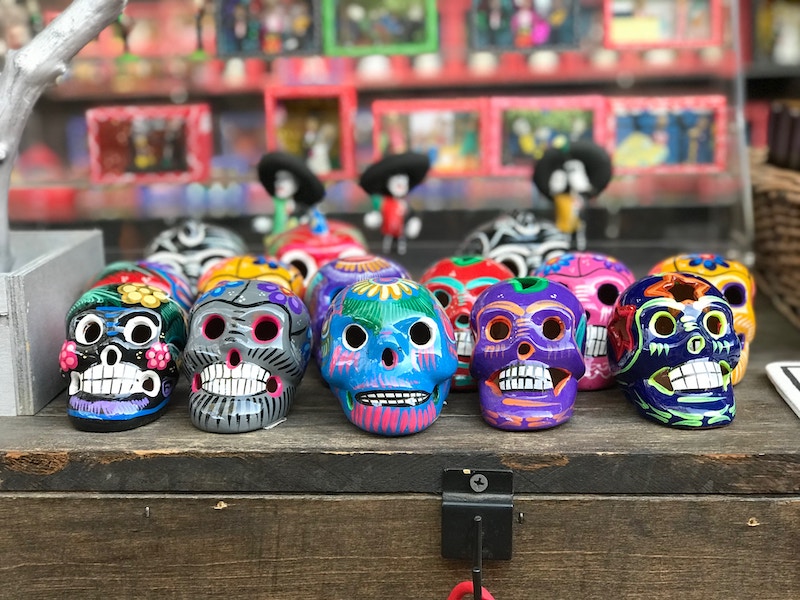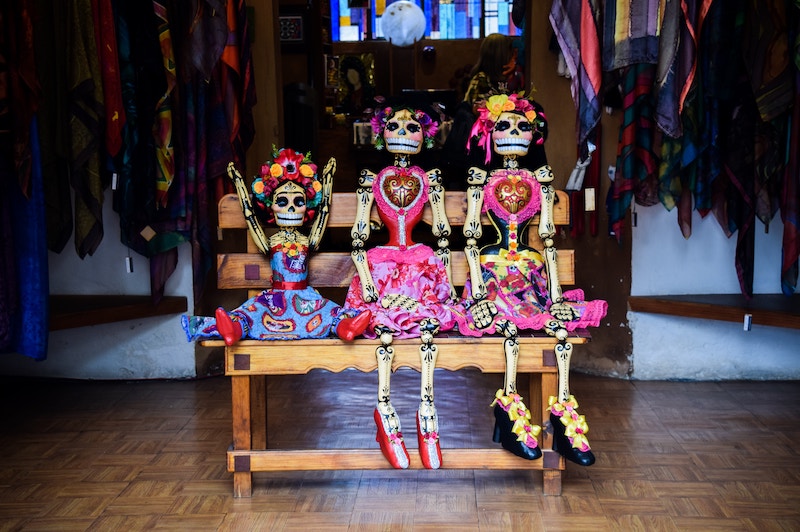Dia de Los Muertos is not my native thing, but am quite interested in it as a cultural heritage in the world, so after seeing bobbleheads in the store, went to collect some info.
Apparently the color of the skull has specific meaning, so you're not quite supposed to buy one for your cockpit because "oh look this one has a hat lol".
Here’s a simple guide:
1. Yellow (amarillo), Mexican marigold (a symbol of death)
Yellow is seen in the many candles lighting up altars, processions, and graveyards.
Meanings:
2. Orange (naranja), Sunshine
Bright orange might be the most iconic color. It’s found in the many marigolds, or flowers of death (flores de cempasúchil – flores de muerto) that decorate altars. The orange marigold petals are often strewn as paths leading to graveyards, with their color and scent beckoning souls to follow.
Meanings:
You can also spot the color orange around a Day of the Dead celebration in the form of painted or hand-crafted monarch butterflies.
3. Black (negro), Land of the Dead
Black is not actually one of the main Day of the Dead colors, but it can be found in some elements, such as La Catrina.
Meanings:
4. White (blanco), Purity
White is found in many of the items for Day of the Dead: candles, sugar skulls, tablecloths, and white flowers used to create paths.
Meanings:
Celebrants often bring white flowers to the altar or use white paper banners and other decorations.
5. Pink (rosad), Hope
While purple represents grief, pink is a color that shows the happiness people feel from being connected to their loved ones during Day of the Dead.
Meanings:
6. Purple (morado), Pain
Purple is used in papel picado and other decorations.
Meanings:
Families often light purple candles in their homes or at altars during Day of the Dead celebrations to acknowledge their feelings of loss.
7. Red (rojo), Blood
Meanings:
8. Blue (azul)
Meanings:
9. Green (verde)
Meanings:
Source:

 www.joincake.com
www.joincake.com

 www.joincake.com
www.joincake.com

 spanishmama.com
spanishmama.com
And since in FDev store we have only three, there's obviously some work to be done!

If anyone wants to add some more info, please do so! The goal is to put some meaning in ED bobbleheads, so you know what's in your cockpit.
o7
Apparently the color of the skull has specific meaning, so you're not quite supposed to buy one for your cockpit because "oh look this one has a hat lol".
Here’s a simple guide:
1. Yellow (amarillo), Mexican marigold (a symbol of death)
Yellow is seen in the many candles lighting up altars, processions, and graveyards.
Meanings:
- Symbol of light.
- Yellow, in candle flames, can represent each soul honored and remembered on a family’s altar.
- Yellow honors those who died at an older age.
2. Orange (naranja), Sunshine
Bright orange might be the most iconic color. It’s found in the many marigolds, or flowers of death (flores de cempasúchil – flores de muerto) that decorate altars. The orange marigold petals are often strewn as paths leading to graveyards, with their color and scent beckoning souls to follow.
Meanings:
- Orange is said to be the only color that visiting souls from the afterlife can see.
- Symbolizes the light of the sun.
You can also spot the color orange around a Day of the Dead celebration in the form of painted or hand-crafted monarch butterflies.
3. Black (negro), Land of the Dead
Black is not actually one of the main Day of the Dead colors, but it can be found in some elements, such as La Catrina.
Meanings:
- Can represent the Mictlan, the Land of the Dead, from PreHispanic traditions.
4. White (blanco), Purity
White is found in many of the items for Day of the Dead: candles, sugar skulls, tablecloths, and white flowers used to create paths.
Meanings:
- Symbolizes of purity, hope, and death.
- White can symbolize the innocence of the souls of babies.
Celebrants often bring white flowers to the altar or use white paper banners and other decorations.
5. Pink (rosad), Hope
While purple represents grief, pink is a color that shows the happiness people feel from being connected to their loved ones during Day of the Dead.
Meanings:
- Symbol of joy.
6. Purple (morado), Pain
Purple is used in papel picado and other decorations.
Meanings:
- Purple is linked to Christian beliefs, and is commonly used to symbolize the death of Jesus.
- In both Catholic and ancient traditions, purple symbolizes grief, acknowledging loss on the part of the family.
Families often light purple candles in their homes or at altars during Day of the Dead celebrations to acknowledge their feelings of loss.
7. Red (rojo), Blood
Meanings:
- Symbolizes the blood of life.
- Can symbolize the blood of Jesus, for certain Christians.
- Honors souls who died in battle and mothers lost in childbirth.
8. Blue (azul)
Meanings:
- Element of water, which thirsty souls might need upon their arrival.
- Honors souls who were lost in water.
9. Green (verde)
Meanings:
- Honors souls who passed on while still young.
Source:

What Is a Sugar Skull (Calavera) & What Does It Represent? | Cake Blog
Learn what a sugar skull, or calavera in Spanish, is, including their origin, meaning, and presence in popular culture.

List of 13 Popular Day of the Dead Symbols & Colors | Cake Blog
Learn about popular Day of the Dead (Día de los Muertos) symbols and colors, including their history, meaning, and more.

What do Day of the Dead Colors and Symbols Mean?
Inside: A guide to Day of the Dead colors and symbols, with different interpretations of what they represent. From the outside, it might seem strange: Day of the Dead is a time dedicated to remembering loved ones who have passed on. It's also a colorful, vibrant holiday. But when we remember...
 spanishmama.com
spanishmama.com
And since in FDev store we have only three, there's obviously some work to be done!
If anyone wants to add some more info, please do so! The goal is to put some meaning in ED bobbleheads, so you know what's in your cockpit.
o7
